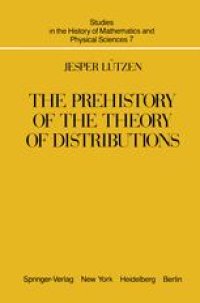
Ebook: The Prehistory of the Theory of Distributions
Author: Jesper Lützen (auth.)
- Tags: Mathematics general
- Series: Studies in the History of Mathematics and Physical Sciences 7
- Year: 1982
- Publisher: Springer-Verlag New York
- Edition: 1
- Language: English
- pdf
I first learned the theory of distributions from Professor Ebbe Thue Poulsen in an undergraduate course at Aarhus University. Both his lectures and the textbook, Topological Vector Spaces, Distributions and Kernels by F. Treves, used in the course, opened my eyes to the beauty and abstract simplicity of the theory. However my incomplete study of many branches of classical analysis left me with the question: Why is the theory of distributions important? In my continued studies this question was gradually answered, but my growing interest in the history of mathematics caused me to alter my question to other questions such as: For what purpose, if any, was the theory of distributions originally created? Who invented distributions and when? I quickly found answers to the last two questions: distributions were invented by S. Sobolev and L. Schwartz around 1936 and 1950, respectively. Knowing this answer, however, only created a new question: Did Sobolev and Schwartz construct distributions from scratch or were there earlier trends and, if so, what were they? It is this question, concerning the pre history of the theory of distributions, which I attempt to answer in this book. Most of my research took place at the History of Science Department of Aarhus University. I wish to thank this department for its financial and intellectual support. I am especially grateful to Lektors Kirsti Andersen from the History of Science Department and Lars Mejlbo from the Mathematics Department, for their kindness, constructive criticism, and encouragement.